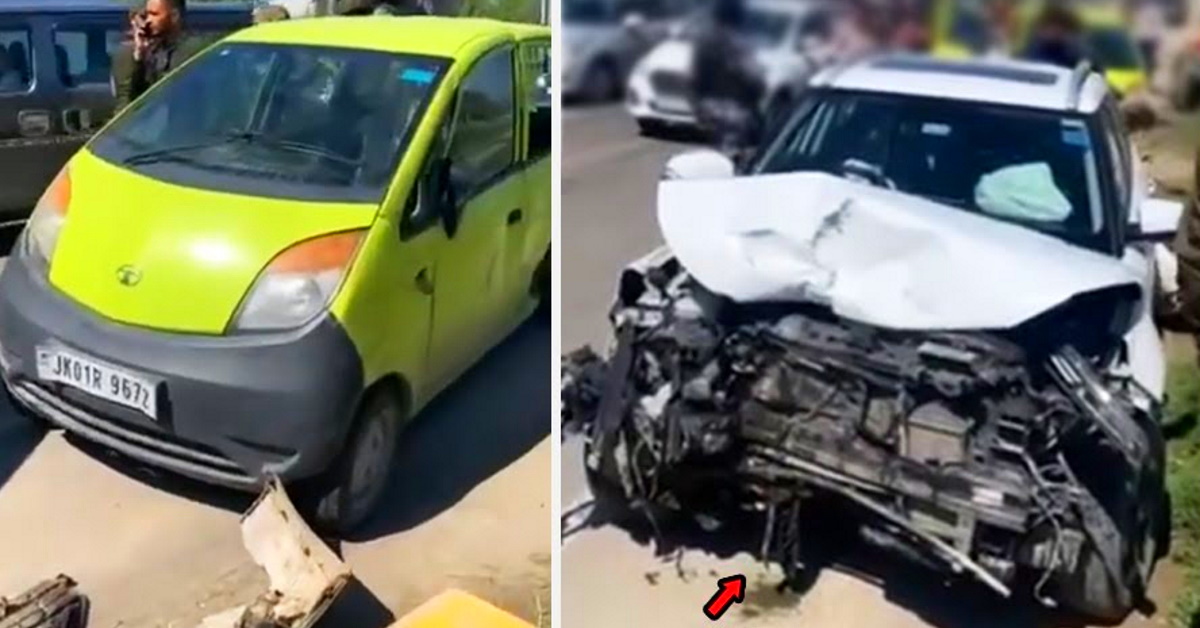Hyundai India Venue sub-4 meter compact SUV hits Tata Motors Nano budget hatchback from behind: Here is the result
There are many who often determine the strength of a vehicle from a road accident. Here is an accident between Hyundai Venue and Tata Nano that many are using to determine the strength of the vehicle. But can you do it from an accident?
The accident between the Tata Nano and the Hyundai Venue happened in Jammu. According to the video, the Hyundai Venue crashed into the Tata Nano’s rear end. The impact from the accident caused major damage to the Venue’s front end and we can also see the open airbags. Whereas, the Tata Nano’s rear end has also received massive damages and the impact has caused the rear axle to break.
None of the passengers are injured in this accident according to the video. However, they have not mentioned how grave the injuries sustained by the passengers of both cars were.
Also read: Tata Punch and Hyundai Venue in a comparison video
Nonetheless, the video says that it is because of Nano’s build quality that it caused so much damage to the Hyundai Venue. But is that the case?
Use of crumple zones in cars
In order to absorb as much energy as possible during a collision, the crumple zones in all modern cars are designed to crumple down. The safe zone, located between these two crumple zones, is engineered to remain intact even during severe crashes, thus protecting the occupants. This safety philosophy is incorporated in all Suzuki vehicles.
Modern cars are equipped with crumple zones, which serve as the first line of defence in an accident. These zones are designed to absorb energy by crumpling easily during a crash, thus ensuring passenger safety. In contrast, the cabin is designed to withstand impacts and not crumple easily, thereby preventing passengers from being crushed in the event of a collision.
Tata Nano, which received a zero star in the Global NCAP test might not have much space to put the crumple zones. In vehicles where the crumple zones are limited, the impact from a crash is transferred to the passengers sitting inside the vehicle.
Also, cars without crumple zones can get more damage than it seems from the outside. While there is not much visible damage to the Tata Nano, we are almost certain that it has got chassis damage because of the impact. Whereas one can change the parts in the Hyundai Venue and make it driveable and roadworthy again, the chassis damage sometimes misaligns the whole car. It makes it undrivable even after the repairs. So next time when you see an accident where one car is more damaged than the other, think about the crumple zones and how they worked to save the passengers.
Also read: Upcoming 2022 Maruti Suzuki Vitara Brezza rendered
There are many who often determine the strength of a vehicle from a road accident. Here is an accident between Hyundai Venue and Tata Nano that many are using to determine the strength of the vehicle. But can you do it from an accident?
The accident between the Tata Nano and the Hyundai Venue happened in Jammu. According to the video, the Hyundai Venue crashed into the Tata Nano’s rear end. The impact from the accident caused major damage to the Venue’s front end and we can also see the open airbags. Whereas, the Tata Nano’s rear end has also received massive damages and the impact has caused the rear axle to break.
None of the passengers are injured in this accident according to the video. However, they have not mentioned how grave the injuries sustained by the passengers of both cars were.
Also read: Tata Punch and Hyundai Venue in a comparison video
Nonetheless, the video says that it is because of Nano’s build quality that it caused so much damage to the Hyundai Venue. But is that the case?
Use of crumple zones in cars

In order to absorb as much energy as possible during a collision, the crumple zones in all modern cars are designed to crumple down. The safe zone, located between these two crumple zones, is engineered to remain intact even during severe crashes, thus protecting the occupants. This safety philosophy is incorporated in all Suzuki vehicles.
Modern cars are equipped with crumple zones, which serve as the first line of defence in an accident. These zones are designed to absorb energy by crumpling easily during a crash, thus ensuring passenger safety. In contrast, the cabin is designed to withstand impacts and not crumple easily, thereby preventing passengers from being crushed in the event of a collision.
Tata Nano, which received a zero star in the Global NCAP test might not have much space to put the crumple zones. In vehicles where the crumple zones are limited, the impact from a crash is transferred to the passengers sitting inside the vehicle.
Also, cars without crumple zones can get more damage than it seems from the outside. While there is not much visible damage to the Tata Nano, we are almost certain that it has got chassis damage because of the impact. Whereas one can change the parts in the Hyundai Venue and make it driveable and roadworthy again, the chassis damage sometimes misaligns the whole car. It makes it undrivable even after the repairs. So next time when you see an accident where one car is more damaged than the other, think about the crumple zones and how they worked to save the passengers.
Also read: Upcoming 2022 Maruti Suzuki Vitara Brezza rendered
